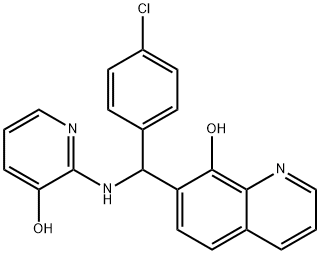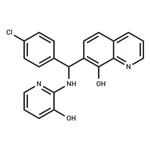Uses
General Uses:Ischemic injury Research, Renal anemia, HIF Prolyl Hydroxylase Inhibitor, Antioxidant, NeuroprotectiveDescription:Adaptaquin inhibits the HIF PHDs in brain in a dose dependent fashion and penetrates blood brain barrier (BBB). Exhibited functional recovery in intra-cerebral hemorrhage rat model; inhibits ATF4 gene. Potent HIF PHD inhibitor (hypoxia inducible factor), Selective PDH2 inhibitor.This compound is suitable for pyruvate dehydrogenase (PDH) related research.
Biological Activity
adaptaquin is a selective hydroxyquinoline hif prolyl hydroxylase (hif-phd) inhibitor [1][2].the hypoxia-inducible factor prolyl hydroxylase domain enzymes (hif-phds) are a family of oxygen sensors that has been implicated in neuronal survival. catalysis by the hif-phds destabilizes the transcriptional activator hif-1a under normoxia. hif-phds are promising target candidates for mitochondrial protection in paradigms of oxidative stress. the inhibition of hif-phds prevented neuronal cell death induced by mitochondrial toxins [1][2].adaptaquin is a hydroxyquinoline hif-phd inhibitor. adaptaquin inhibited purified and recombinant phd2. adaptaquin (30 mg/kg) penetrated the blood-brain barrier, resulting in inhibition of the oxygen-sensing hif-phds and activation of hif-dependent gene expression [1]. in ht-22 cells, adaptaquin protected against glutamate-induced cell death. adaptaquin could also restore the mitochondrial atp production [2].in intracerebral hemorrhage (ich) mice model, adaptaquin decreased edema and significantly improved tape removal task, which were associated with a reduction in the number of degenerating neurons in perihematomal and hematomal areas of the mouse striatum [1].
Enzyme inhibitor
This brain-penetrant PHD2 inhibitor and antioxidant (FW = 377.82 g/mol; CAS 385786-48-1; Soluble to 100 mM in DMSO), also named 7-[(4chlorophenyl)[(3-hydroxy-2-pyridinyl)amino]methyl]-8-quinolinol, targets Hypoxia-Inducible Factor (or HIF) prolyl hydroxylase-2, a critical regulator of hematopoietic stem cell (HSC) maintenance during steadystate and stress. Indeed, this branched oxyquinoline molecule was named adaptaquin (AQ) to signify its ability to inhibit the HIF-PHDs and activate adaptive responses to hypoxia. Hypoxia is a prominent feature in the maintenance of HSC quiescence and multipotency. Adaptaquin also exhibits neuroprotective effects, enhancing functional recovery in rodent intracerebral hemorrhage models, via inhibition of ATF4 dependent genes.
References
[1]. karuppagounder ss, alim i, khim sj, et al. therapeutic targeting of oxygen-sensing prolyl hydroxylases abrogates atf4-dependent neuronal death and improves outcomes after brain hemorrhage in several rodent models. sci transl med. 2016 mar 2;8(328):328ra29.
[2]. neitemeier s, dolga am, honrath b, et al. inhibition of hif-prolyl-4-hydroxylases prevents mitochondrial impairment and cell death in a model of neuronal oxytosis. cell death dis. 2016 may 5;7:e2214.

